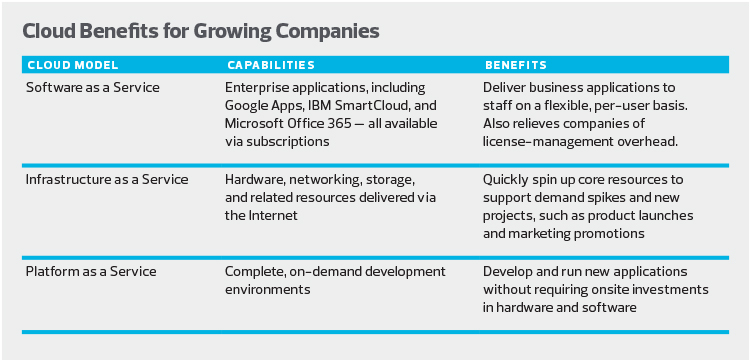Small Business Growth Requires Strategic IT Planning
More on Small Business Best Practices for Growth:
5 Strategies for Moving Your Business to the Cloud
Updating Technology Remains a Key Challenge for Growing Small Businesses
Small Businesses Embrace Managed Services for Various IT Needs
4 Keys to Finding a Managed Services Partner
Small Businesses Should Target Their Security Spending
Think It’s Time to Go All-In on the Cloud? Think Again
The first step for small business success is to create a business model that resonates with a target market and generates growing profits. An often-perilous next step? Don’t implode if that strategy succeeds beyond your wildest dreams.
“Some companies are stunned by their own success,” says Laurie McCabe, cofounder and partner at the SMB Group, a research firm. “It can make you acutely feel all the gaps where you’re leaking efficiency.”
Even a welcome influx of new funding, such as from a Small Business Administration loan or a venture capitalist, can be a source of confusion and uncertainty. Small business operators know they must expand their IT operations to support their growing companies, but many wonder how to target the money so it does the most good today, while creating an agile foundation for the future.
The answer, according to experts who work closely with small businesses, is a comprehensive investment strategy that addresses essential infrastructure components and makes smart choices about balancing purchases with the wide range of IT services now available to high-growth companies. These experts say small business leaders should focus on several key technology areas to maintain a smooth, productive growth curve.
Warming Up to the Cloud
“We’ve been talking about the impact of cloud for a while. Now, small businesses are really embracing it,” says Andy Bose, chairman and CEO of AMI Partners.
Recent research by the firm found that 15 percent of IT spending by North American small and midsized businesses is going to cloud solutions, and investments are on track to rise to about 25 percent over the next year and 40 percent in about three years, he says.
AMI’s research also shows that one of the early appeals of the cloud — the potential to reduce overall costs — isn’t necessarily a driving force for today’s adoptions. Instead, small business decision-makers see the cloud as a tool for increasing revenue, improving operational efficiency, providing scalability to support growth and new business models, and dialing capacity up and down as needs change, Bose says.

For reasons such as these, many small businesses are taking a cloud-first strategy to new IT investments, says Anil Desai, an independent IT consultant. “Cloud allows the IT staff to focus most of its time on activities that can add value to the business, rather than on maintenance and break/fix tasks,” he says.
A Strong Connectivity Foundation
Cloud services, as well as onsite resources, can’t run effectively without a secure and reliable network foundation. It’s a message that’s clearly gotten through to growing companies. Already, about 70 percent of IT decision-makers at small companies rank improved network connectivity as a top priority, Bose says. “As cloud deployments continue to increase, connectivity will become even more important,” he adds.
Small businesses need a multifaceted approach to networking, experts say. Growing companies should negotiate bandwidth guarantees with wide area network service providers, along with contracts designed for flexibility. If 1 gigabit per second of bandwidth meets today’s needs, companies should be able to increase to 2Gbps, 10Gbps or higher as the cloud and bandwidth-hungry applications eat up capacity.
Some cloud providers are also teaming with Internet service providers to ensure that customers have high-speed access. For example, Microsoft Azure ExpressRoute lets small businesses create private connections to Azure data centers.
Because mobility is a disruptive force across all types of industries, fast, secure and reliable Wi-Fi is also a must. Managed Wi-Fi services can reduce the burden on internal IT staff when it comes to deploying and maintaining access points, upgrades and other wireless duties. Whether outsourced or handled internally, regular site surveys can identify shifting traffic patterns, bottlenecks and the need for additional access points. The latest iteration of the IEEE’s wireless networking standard, 802.11ac, provides additional performance and flexibility to support business growth.
Onsite Servers Offer Advantages
No matter how committed small businesses are to the cloud, onsite servers will continue to play an important role in delivering business services. The need for fast performance to process e-commerce transactions, for example, demands low latency that’s often best achieved with in-house hardware.
Some firms are even dialing back cloud services in favor of a larger on-premises footprint. “They’re now realizing it’s more practical and cost-effective to bring some resources in-house,” says Amy DeCarlo, principle analyst for data center and security services at Current Analysis.
For example, if a growing company decides to open a new location, it may find that available Internet services aren’t reliable. Others may rethink the cloud because expenses associated with migrating data were higher than expected, or a provider’s service levels were inadequate.
No matter the motivation, the continuing evolution in server technology means IT managers will find choices designed for their needs.
The Flexibility of Converged Infrastructure
Technology for optimizing in-house data centers continues to evolve, giving high-growth businesses options for enhancing flexibility. One option that many small businesses are considering is converged infrastructure, an approach that delivers integrated bundles of computing, storage and network resources, as well as the software to manage them. Ever-larger numbers of small businesses are adopting these solutions, according to Techaisle, a global IT market research and analysis organization. This increased adoption comes on the heels of $3.8 billion in spending by U.S. small and midsized for converged infrastructure in 2014, Techaisle stated.
The research found that top business drivers include improved IT agility and the ability to meet business needs, as well as cost savings and improved security.
Leading solutions include HPE’s Hyper Converged Systems, which can be designed specifically for small and midsized businesses. Hyper-convergence, an evolution of converged infrastructure, leverages software-defined technology to tightly integrate IT capabilities within a converged model. Another solution targeted toward small businesses is ExpressPod, which combines technology from NetApp and Cisco. An ExpressPod appliance can consolidate core business applications, such as email, collaboration and content management, within a single infrastructure.

SOURCE: IDC, "U.S. Small and Medium-Sized Business 2015-2019 Forecast," March 2015
The Benefits of IT Standardization
For desktops and notebook computers, savvy IT departments are turning to standardization to reduce maintenance and support challenges. In addition to saving IT staff from having to maintain and troubleshoot multiple systems, standardization reduces the burden on IT professionals who attend training courses and maintain certifications to stay on top of hardware developments.
“Management consistency from standardization helps with areas like updating device drivers or making sure the operating systems are current for all devices,” says Desai. “And if you run into a problem with a certain network driver, for example, you don’t have to search for the latest drivers for dozens of different configurations.”
Similar benefits come from running only a limited range of business applications and loading hardware with standard images, a consistent configuration of operating systems, applications and system software, he adds.
A Variety of Storage Options
IT managers are on a constant hunt for adequate and economical storage to handle the ever-increasing volumes of data that businesses compile and create. Research by the SMB Group indicates that this need is pushing businesses to hybrid strategies that combine onsite and cloud-based storage, says McCabe. “This includes moving files to solutions such as Box and Dropbox for sharing information,” she adds.
The downside? “It’s so easy to put corporate information into the cloud, there’s a lot of rogue storage out there, and IT managers are finding it hard to know where it all resides,” McCabe says. “The bottom line is that companies need to make IT-approved resources so easy for people to use that they just naturally take advantage of them.”
With a robust storage infrastructure in place, growing companies can layer on sophisticated business capabilities, such as data analytics. McCabe advises small business decision-makers to look for solutions that offer out-of-the-box analytics, such as a financial system, for example, that can capture real-time data and display summarized information in electronic dashboards tailored for individual users’ roles and responsibilities.
In addition, applications such as Microsoft’s Power BI create visual representations of data, including charts, graphs and maps. These can help business users quickly understand emerging trends revealed in corporate data for informed decisions.
More advanced analytics solutions may provide a competitive advantage, but often require specialized help. “At a certain point, the small business staff may need a partner who understands the business and can help them act on the data most important to the company,” McCabe says.
Secret Weapon: Managed IT Services
Optimizing IT systems is a challenge for many small businesses, especially as they’re trying to keep pace with fast growth. Many are turning to managed IT services for support.
The trade association CompTIA found that 56 percent of companies with 100 or more employees and 47 percent of companies with fewer than 100 employees are turning to service providers to improve the efficiency and reliability of IT operations.
“A managed services provider offers immediate access to the latest technology, along with the talent to keep it running successfully,” says John Chancellor, a managed services solution architect for CDW. “Customers also get a burstable pool of engineering resources. This enables companies to eliminate the restraint of having to recruit IT talent, which can actually slow down their growth.”
A full-service provider can support a comprehensive range of IT needs. For example, in addition to planning and deployment services, CDW can deliver managed services to maintain IT operations on a continuous basis. Its portfolio includes networking, security, software management, cloud aggregation, mobility, collaboration and data center oversight.
Maintaining a Balance While Multitasking
Expanding IT capabilities to meet growing business needs can challenge even the best multitaskers. After all, as IT staffs work to implement new business services, they must also ensure that existing systems and workflow processes continue to deliver the performance expected by end users and customers. These considerations must be an integral part of the planning that goes into every upgrade project. “This balancing act is one area where an outside consultant with relevant expertise can be especially valuable,” DeCarlo says.
For more information on CDW solutions that can help small businesses, check out CDW.com/small-business.









